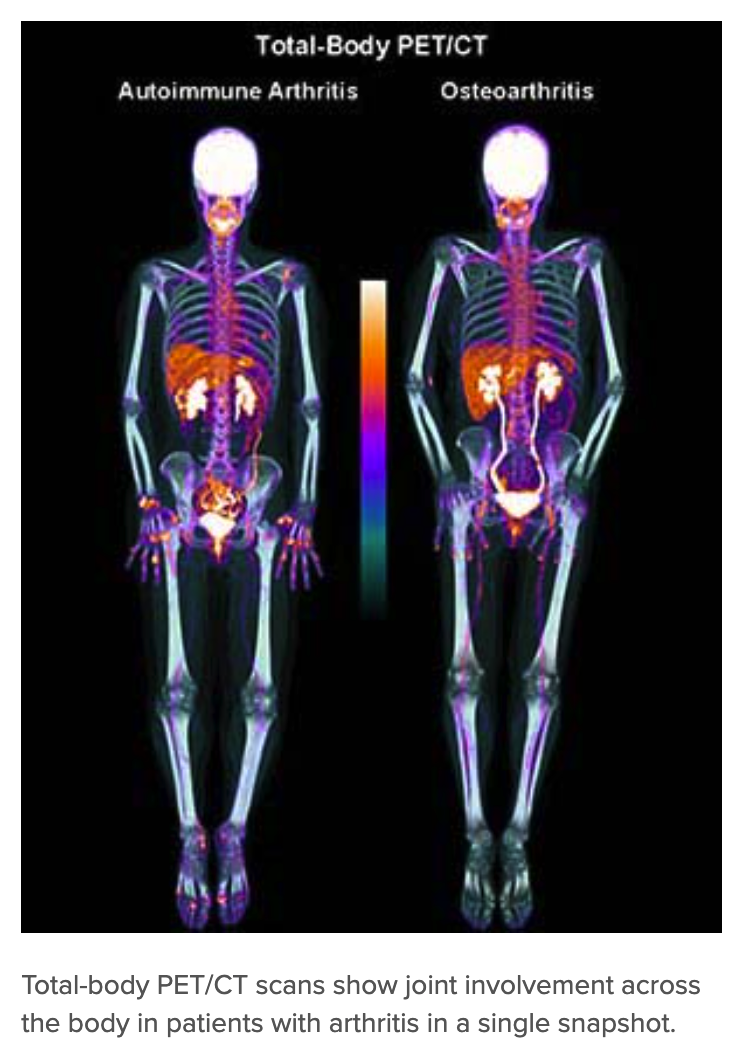Full-Body PET Identifies Biomarkers of Joint Inflammation
 A team from the University of California, Davis have performed the first human study using a full-body PET scan to identify the biomarkers for autoimmune inflammatory arthritis. The UC David-developed EXPLORER Total Body Scanner, the first and only total body PET scanner approved by the US FDA, acquires PET imaging of the body, from head to toe, all at the same time.
A team from the University of California, Davis have performed the first human study using a full-body PET scan to identify the biomarkers for autoimmune inflammatory arthritis. The UC David-developed EXPLORER Total Body Scanner, the first and only total body PET scanner approved by the US FDA, acquires PET imaging of the body, from head to toe, all at the same time.
This first-of-its-kind study published in the Journal of Nuclear Medicine offers promising results that introduce novel means to assess joint inflammation that would aid clinicians in monitoring and treating a patient’s condition.
"Autoimmune arthritis is a chronic systemic disorder, so essentially it affects the whole body," explained Abhijit J. Chaudhari, PhD, professor of radiology and lead investigator of the study. "Historically the evaluation of the condition has been via a physical exam on a small number of joints by a rheumatologist or by x-rays. In this study, our full-body PET scan gives us an entire picture of the body's small and large joints at the same time. This allows a clinician to get a much better picture of the disease activity."
Thirty participants diagnosed with rheumatoid arthritis, psoriatic arthritis (both autoimmune) and osteoarthritis (non-autoimmune) received a small injection of a radioactive sugar called Fluorodeoxyglucose. This showed the team which joints in the body has active inflammation, due to those areas containing more sugar.
The study suggests that traditional rheumatology assessments may be missing some arthritic joints. In fact, in participants diagnosed with an autoimmune arthritis, a full 20% of joints that were deemed negative during an assessment were found to be active during the Total Body PET scan.
“The results of this study are not surprising,” said Siba Raychaudhuri, MD, professor of internal medicine and director of the Rheumatology and Immunology Training Fellowship Program at UC Davis and co-leader of the study. “During a physical exam, the sensitivity to joint inflammation is not consistent throughout the body. Therefore, imaging provides us a clearer picture of which joints are being affected by inflammation and provides us a clearer picture of how to treat our patients.”
Moving forward, the team plans to analyze entheseal tissues (where ligaments attach to the bone), fingers, muscles and nails where inflammation may manifest. They’ll also study large organs that are impacted by autoimmune conditions.
“We are hopeful that total-body PET imaging can provide currently unavailable, systemic biomarkers that could help address the significant clinical challenges in managing autoimmune inflammatory arthritic populations,” said Chaudhari. “This insight will help reveal the most promising new biological targets for drug development and match existing drugs to patients with specific molecular profiles who are most likely to benefit.”
